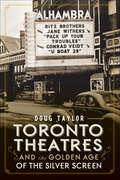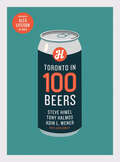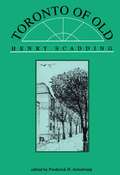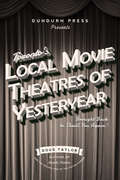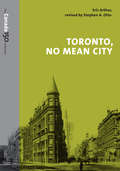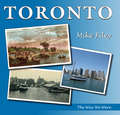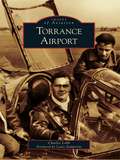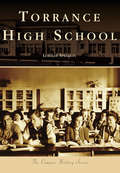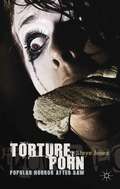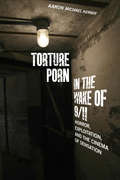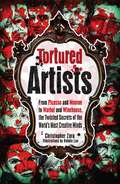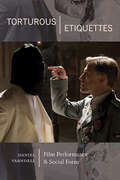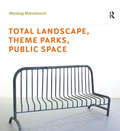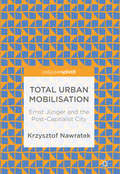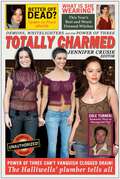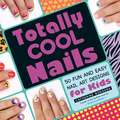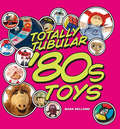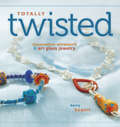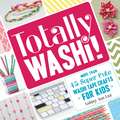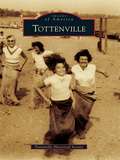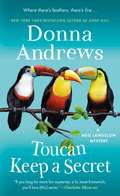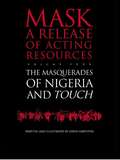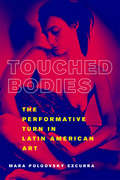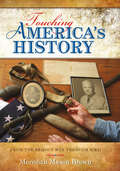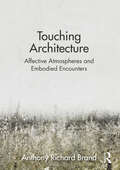- Table View
- List View
Toronto Theatres and the Golden Age of the Silver Screen (Landmarks)
by Doug TaylorThe history, heritage, and architectural significance of Toronto's most notable theatres and movie houses. Movie houses first started popping up around Toronto in the 1910s and '20s, in an era without television and before radio had permeated every household. Dozens of these grand structures were built and soon became an important part of the cultural and architectural fabric of the city. A century later the surviving, defunct, and reinvented movie houses of Toronto's past are filled with captivating stories. Explore fifty historic Toronto movie houses and theaters, and discover their roles as repositories of memories for a city that continues to grow its cinema legacy. Features stunning historic photography.
Toronto in 100 Beers
by John Semley Steve Himel Adin L. Wener Tony HalmosDiscover Toronto’s wild, weird history and the 100 unique beers it inspired! Did you know that Babe Ruth hit his first home run in Toronto? Or that the city’s first taxi service was operated by a former slave from the American South? Or that, during the Second World War, anti-submarine technology was developed in a carriage house at Casa Loma? These are the sorts of stories Henderson Brewing Company has been celebrating with their monthly “Ides” series: unique brews that pay tribute to just-as-unique moments in Toronto’s history. Toronto in 100 Beers is more than a history of Henderson’s limited releases, it’s a history of the city itself—a city that has nurtured the lives and legends of artists, golfers, boxers, prog rockers, prestidigitators, hockey legends, and even a few ghosts. This book collects their stories and those of the beers dreamt up in their honour. Toronto is a wild, weird city whose rich history is worthy of celebration—so raise a glass to Toronto and to the Henderson Brewing Company.
Toronto of Old: Collections and Recollections Illustrative of the Early Settlement and Social Life of the Capital of Ontario
by Henry ScaddingIn 1873, Henry Scadding, former rector of Toronto's Church of the Holy Trinity, wrote the definitive history of early Toronto. His detailed portrait of the streets, customs and prominent citizens is a goldmine of sights and insights into a Toronto long-since disappeared. Toronto of Old was first reprinted in 1966 and has been out of print since 1973. The later version, edited by Frederick H. Armstrong is shorter than the original, with Scadding's references to outside cities and characters shortened or omitted to give the book a sharper focus on Toronto. This second edition is an updated and corected version of the 1966 edition. The best history of Toronto ever written, "Toronto of Old" by Henry Scadding, has just been edited by Professor F.H. Armstrong of the University of Western Ontario ... Armstrong's editing, with his written reasons for a series of cuts, has made it a tighter and more informative book than the original. - Gordon Sinclair in Let's Be Personal
Toronto's Local Movie Theatres of Yesteryear: Brought Back to Thrill You Again
by Doug Taylor2017 Theatre Library Association Book Awards — Nominated, Richard Wall Memorial Award 2017 Heritage Toronto Book Award — Nominated Slip once more into the back rows of the favourite movie theatres of your youth. “Brought Back to Thrill You Again” was an advertisement employed by theatres to disguise that they were offering older films that were past their prime. In the 1950s a sign appeared outside Loew’s Downtown (the Elgin) displaying these commonly used words. The theatre was screening Gone With the Wind, released in 1939. However, in this instance the claim was accurate, as the film did indeed thrill audiences one more time. Similar to this cinematic classic, this book will thrill you again as it brings back memories of Toronto’s old movie theatres. Relive the experience of sitting in their darkened auditoriums, witnessing the adventure, comedy, and romance of the silver screen. Most of the theatres have been demolished, but to visually recreate them, the book includes 128 historic pictures of the theatres — exteriors, marquees, colourful neon signs, and auditoriums — many of the photos never before published in books or on the internet.
Toronto, No Mean City
by Stephen Otto Eric ArthurEric Arthur fell in love with Toronto the first time he saw it. The year was 1923; he was twenty-five years old, newly arrived to teach architecture at the University of Toronto. For the next sixty years he dedicated himself to saving the great buildings of Toronto's past. Toronto, No Mean City sounded a clarion call in his crusade. First published in 1964, it sparked the preservation movement of the 1960s and 1970s and became its bible. This reprint of the third edition, prepared by Stephen Otto, updates Arthur's classic to include information and illustrations uncovered since the appearance of the first edition.Four new essays were commissioned for this reprint. Christopher Hume, architecture critic and urban affairs columnist for the Toronto Star, addresses the changes to the city since the appearance of the third edition in 1986. Architect and heritage preservation activist Catherine Nasmith assesses the current status of the city's heritage preservation movement. Susan Crean, a freelance writer in Toronto, explores Toronto's vibrant arts scene. Mark Kingwell, professor and cultural commentator, reflects on the development of professional and amateur sports in and around town.Readers will delight in these anecdotal accounts of the city's rich architectural heritage.
Toronto: The Way We Were
by Mike FileyFor decades Toronto historian Mike Filey has regaled readers with stories of the city’s past through its landmarks, neighbourhoods, streetscapes, social customs, pleasure palaces, politics, sporting events, celebrities, and defining moments. Now, in one lavishly illustrated volume, he serves up the best of his meditations on everything from the Royal York Hotel, the Flatiron Building, and the Necropolis to Massey Hall, the Palais Royale, and the Canadian National Exhibition, with streetcar jaunts through Cabbagetown, the Annex, Rosedale, and Little Italy and trips down memory lane with Mary Pickford, Glenn Miller, Bob Hope, and Ed Mirvish.Filey recounts in vivid detail the devastation of city disasters such as Hurricane Hazel and the Great Fire of 1904 and spins yarns about doughnut shops old and new, milk deliveries by horse, swimming at Lake Ontario’s beaches, Sunday blue laws, and how both World Wars affected Torontonians.
Torrance Airport (Images of Aviation)
by Louis Zamperini Charles LobbCalifornians were panicked by the Pearl Harbor attack of December 7, 1941, and civilian flights within 200 miles of the coast were immediately terminated. Airfields were commandeered and new ones hastily built. One of these was the Lomita Flight Strip, known today as Zamperini Field, the Torrance Municipal Airport, or TOA. This 490-acre parcel sent four squadrons of P-38 fighter pilots off to war with one commanded by the judge of the Charles Manson trial, an ex-Flying Tiger. Six other pilots became generals, two became commandants of cadets at the Air Force Academy, and one became the only fighter pilot with combat victories in both World War II and the Vietnam War. Japanese Americans returning from World War II internment camps found temporary housing at the field, and the world's largest manufacturer of civilian helicopters settled there in 1973. The first runway takeoff of a Vertical Take-Off and Landing (VTOL) aircraft was pioneered at TOA, and aerobatic champ Bob Herendeen trained at the site.
Torrance High School (Campus History)
by Loralee SpradlinIn 1917, when Torrance School first opened, the city of Torrance was developing a reputation as an industrial powerhouse. The new school initially served all school-age children in one building. By 1923, the elementary students had their own school, and Torrance High School stood as the only high school until the 1950s. As the population of the city grew, so did the campus of Torrance High. The rich history of Torrance High School is filled with academic and athletic successes, as well as storied alumni like Louis Zamperini and Ted Tanouye, who served the United States during World War II. In the 1990s, the highly recognizable Main Building served as a set for several television shows, including Beverly Hills, 90210 and Buffy the Vampire Slayer, and movies, such as She�s All That and Not Another Teen Movie.
Torture Porn
by Steve JonesThe first monograph to critically engage with the controversial horror film subgenre known as 'torture porn', this book dissects press responses to popular horror and analyses key torture porn films, mapping out the broader conceptual and contextual concerns that shape the meanings of both 'torture' and 'porn'.
Torture Porn in the Wake of 9/11
by Aaron Michael KernerSaw, Hostel, The Devil's Rejects: this wave of horror movies has been classed under the disparaging label "torture porn." Since David Edelstein coined the term for a New York magazine article a few years after 9/11, many critics have speculated that these movies simply reflect iconic images, anxieties, and sadistic fantasies that have emerged from the War on Terror. In this timely new study, Aaron Kerner challenges that interpretation, arguing that "torture porn" must be understood in a much broader context, as part of a phenomenon that spans multiple media genres and is rooted in a long tradition of American violence. Torture Porn in the Wake of 9/11 tackles a series of tough philosophical, historical, and aesthetic questions: What does it mean to call a film "sadistic," and how has this term been used to shut down critical debate? In what sense does torture porn respond to current events, and in what ways does it draw from much older tropes? How has torture porn been influenced by earlier horror film cycles, from slasher movies to J-horror? And in what ways has the torture porn aesthetic gone mainstream, popping up in everything from the television thriller Dexter to the reality show Hell's Kitchen? Reflecting a deep knowledge and appreciation for the genre, Torture Porn in the Wake of 9/11 is sure to resonate with horror fans. Yet Kerner's arguments should also strike a chord in anyone with an interest in the history of American violence and its current and future ramifications for the War on Terror.
Tortured Artists: From Picasso and Monroe to Warhol and Winehouse, the Twisted Secrets of the World's Most Creative Minds
by Christopher ZaraGreat art comes from great pain.Or that's the impression left by these haunting profiles. Pieced together, they form a revealing mosaic of the creative mind. It's like viewing an exhibit from the therapist's couch as each entry delves into the mental anguish that afflicts the artist and affects their art.The scope of the artists covered is as varied as their afflictions. Inside, you will find not just the creators of the darkest of dark literature, music, and art. While it does reveal what everyday problem kept Poe's pen to paper and the childhood catastrophe that kept Picasso on edge, it also uncovers surprising secrets of more unexpectedly tormented artists. From Charles Schultz's unrequited love to J.K. Rowling's fear of death, it's amazing the deep-seeded troubles that lie just beneath the surface of our favorite art.As much an appreciation of artistic genius as an accessible study of the creative psyche, Tortured Artists illustrates the fact that inner turmoil fuels the finest work.
Torturous Etiquettes: Film Performance and Social Form (SUNY series, Horizons of Cinema)
by Daniel Varndell"Etiquette," as noted toastmaster Herbert V. Prochnow once pointed out, "is knowing how to yawn with your mouth closed"—that is, to spare the feelings of the other person, one must stifle one's own. To be polite, therefore, is to perform. Onscreen, closeups often reveal the effort that goes into maintaining that performance: with a fleeting frown or a slight scowl, an actor reveals the "torture" of mannered behavior. In Torturous Etiquettes, Daniel Varndell examines such gestures to reveal the difficulties of the social encounter. Drawing on the history of etiquette, the book deconstructs an array of examples from classical and contemporary Hollywood and European cinema, taking a close look at onscreen representations of rudeness, ridiculing, racist and sexist etiquettes, hospitality, table manners, and more. In doing so, it reveals etiquette to be a persistent theme in cinema and questions the role it plays in either upholding or denying the basic humanity of others.
Total Landscape, Theme Parks, Public Space (Design and the Built Environment)
by Miodrag MitrasinovicPlacing theme parks from the United States, Europe and Asia in a comparative, multidisciplinary framework, this fascinating book argues that these fantasy environments are an extreme example of the totalization of public space. By illuminating the relationship between theme parks and public space, this book offers critical insights into the ethos of total landscape. Illuminating the relationship between theme parks and public space, the book offers an insight into the ethos, design and expectations of public space in the twenty-first century.
Total Urban Mobilisation: Ernst Jünger and the Post-Capitalist City
by Krzysztof NawratekIn this book Krzysztof Nawratek explores the possibility of a post-capitalist city, and in so doing, reclaims and develops the idea of total mobilisation as originally formulated by Ernst Jünger. Nawratek formulates the idea of ‘accumulation of agency’ the ability to act, to replace the logic of capital accumulation as a main driver of urban development. He argues that this ‘accumulation of agency’ operates already in contemporary cities, and should not be seen as essential element of capitalism, but as a conceptual gateway to a post-capitalist world.
Totally Charmed: Demons, Whitelighters And the Power of Three
by Jennifer Crusie and Leah WilsonFrom Cole's downfall and Phoebe's somewhat questionable fashion sense to the power of three in history and literature and a magical tourist's guide to the Halliwells's hometown of San Francisco, this clever, lighthearted essay collection offers a fun and funny look at the world of the WB hit series Charmed. Edited by New York Times bestselling author Jennifer Crusie, these accessible and entertaining essays apply the wit and insight of one of today's leading romance authors to the stylish, occasionally campy fan favorite known for its scandalous outfits, revolving door of love interests, and the magical mayhem of three otherwise normal sisters who must fight against evil as they deal with the challenges of everyday life.
Totally Cool Nails: 50 Fun and Easy Nail Art Designs for Kids
by Catherine RodgersSay hello to fabulous nail art designs you can create!It's time to get your nails noticed! Catherine Rodgers, the creator of the popular nail art YouTube Channel Totally Cool Nails, shows you how to paint one-of-a-kind nail art designs right in your own home. With her guidance and helpful tips, you'll create 50 super-stylish nail art designs like Starfish, Rainbow Wave, Candy Heart, and Watermelon Nails. She also shares her secrets for giving yourself the perfect manicure, including how to prep your nails, use popular nail art tools, and personalize the designs. Whether you're looking for a super-stylish pattern or a fun holiday nail art design, this guide has a fantastic option for every occasion and mood.Complete with step-by-step instructions and full-color photographs of each project, Totally Cool Nails gives you awesome nails--every time!
Totally Tubular '80s Toys
by Mark BellomoFilled with super rad toys and bodacious memories, Totally Tubular '80s Toys is a righteous ride back in time when Madonna ruled and Spinal Tap amplifiers went to 11. You'll find everything from He-Man to Cabbage Patch Kids, Trivial Pursuit to Rubik's Cube, Transformers to Teenage Mutant Ninja Turtles, and Pac-Man to Mario Bros Donkey Kong-as well as lots of fun and smiles.You'll enjoy: A Year-by-year look at the greatest toys of the '80s Awesome color photos featuring more than 500 fabulous toys and period shots of the people who made the decade gnarlyLists of the top 10 TV shoes, movies, and music for each year As Keanu Reeves put it more than 30 times in Bill & Ted's Excellent Adventure, "Whoa!"
Totally Twisted: Innovative Wirework + Art Glass Jewelry
by Kerry BogertThis fresh approach to design shows jewelry artists the secret to combining sterling silver wire with colored wire and glass beads to produce high-end looks. Tips and tricks for making easier, more successful wirework accompany the 20 designs for earrings, bracelets, and necklaces. Techniques for coiling and wire wrapping are included along with how-to's for making clasps and wire components. Along with suggestions for exploring color in jewelry creation, the manual also features variation ideas to show how simply changing colors in a design can transform a piece. Necessary methods and project outlines are displayed through step-by-step photos and offer wire crafters the opportunity to hone their talents to produce unique and creative pieces.
Totally Washi!: More Than 45 Super Cute Washi Tape Crafts for Kids
by Ashley Ann LazStick on the fun!Say hello to a whole new way of decorating! With Totally Washi!, you'll learn how to use washi tape, a colorful Japanese crafting tape, to transform everyday items into adorable creations everyone will love. Featuring 50 awesome washi tape projects, this book encourages you to let your imagination roam free as you cover your locker, bedroom, and even your friends' accessories in the stylish tape. Best of all, when you're bored with the look, you can simply peel off the tape and start all over again! The possibilities are endless with fun washi tape crafts like:Cloud & raindrop bookmarkBraided friendship braceletsCutout art framesBobby pin flowerLocker dry erase board Complete with step-by-step instructions and full-color photos, Totally Washi! will show you how to customize just about anything!
Tottenville: A Staten Island Community Its People, Industry And Architecture: The Town The Oyster Built (Images of America)
by Tottenville Historical SocietyTottenville, located at the southernmost point in New York State, has long been considered the forgotten town in the forgotten borough of New York City. The area was first populated in the 1600s by the Lenni Lenape Indians who summered on its shores, assured of a bountiful harvest from the sea. Bordered on three sides by water, the town had its roots in the oyster fishing, shipbuilding, and ship repair industries and grew rapidly. The Verrazano Bridge, opened in the 1960s, connected Staten Island to Brooklyn and caused a building boom island-wide. Despite the tremendous growth in population, Tottenville retains its small-town feel and offers residents an oasis from big city life in the form of a welcoming and tight-knit community.
Toucan Keep a Secret: A Meg Langslow Mystery (Meg Langslow Mysteries #23)
by Donna AndrewsToucan keep a secret, if one of them is dead.Meg Langslow is at Trinity Episcopal Church locking up after an event and checking on the toucan her friend Rev. Robyn Smith is fostering in her office. When she investigates the sound of hammering in the columbarium (the underground crypt where cremated remains are buried), Meg finds the murdered body of an elderly parishioner. Several niches have been chiseled open; several urns knocked out; and amid the spilled ashes is a gold ring with a huge red stone. The curmudgeonly victim had become disgruntled with the church and ranted all over town about taking back his wife's ashes. Did someone who had it in for him follow him to the columbarium? Or was the motive grave robbery? Or did he see someone breaking in and investigate? Why was the ruby left behind? While Chief Burke investigates the murder, Robyn recruits Meg to contact the families of the people whose ashes were disturbed. While doing so, Meg learns many secrets about Caerphilly's history—and finds that the toucan may play a role in unmasking the killer. Clues and events indicate that a thief broke into the church to steal the toucan the night of the murder, so Meg decides to set a trap for the would-be toucan thief—who might also be the killer. Toucan Keep a Secret is the twenty-third book in New York Times bestselling author Donna Andrews' hilarious Mag Langslow mystery series.
Touch and the Masquerades of Nigeria (Mask - A Release Of Acting Resources Ser. #Vol. 4)
by David Griffiths D. GriffithsFirst published in 1997. Routledge is an imprint of Taylor & Francis, an informa company.
Touched Bodies: The Performative Turn in Latin American Art
by Mara Polgovsky EzcurraWhat is the role of pleasure and pain in the politics of art? In Touched Bodies, Mara Polgovsky Ezcurra approaches this question as she examines the flourishing of live and intermedial performance in Latin America during times of authoritarianism and its significance during transitions to democracy. Based on original documents and innovative readings, her book brings politics and ethics to the discussion of artistic developments during the “long 1980s”. She describes the rise of performance art in the context of feminism, HIV-activism, and human right movements, taking a close look at the work of Diamela Eltit and Raúl Zurita from Chile, León Ferrari and Liliana Maresca from Argentina, and Marcos Kurtycz, the No Grupo art collective, and Proceso Pentágono from Mexico. The comparative study of the work of these artists attests to a performative turn in Latin American art during the 1980s that, like photography and film before, recast the artistic field as a whole, changing the ways in which we perceive art and understand its role in society.
Touching America's History: From the Pequot War Through WWII (Encounters: Explorations in Folklore and Ethnomusicology)
by Meredith Mason BrownObjects that make the past feel real, from a stone axe head to a piece of John Brown&’s scaffold—includes photos. History isn&’t just about abstract &“isms&”—it&’s the story of real events that happened to real people. In Touching America&’s History, Meredith Mason Brown uses a collection of such objects, drawing from his own family&’s heirlooms, to summon up major developments in America&’s history. The objects range in date from a Pequot stone axe head, probably made before the Pequot War in 1637, to the western novel Dwight Eisenhower was reading while waiting for the weather to clear so the Normandy Invasion could begin, to a piece of a toilet bowl found in the bombed-out wreckage of Hitler&’s home in 1945. Among the other historically evocative items are a Kentucky rifle carried by Col. John Floyd, killed by Indians in 1783; a letter from George Washington explaining why he will not be able to attend the Constitutional Convention; shavings from the scaffold on which John Brown was hanged; a pistol belonging to Gen. William Preston, in whose arms Gen. Albert Sidney Johnston bled to death after being shot at the Battle of Shiloh; and the records of a court-martial for the killing by an American officer of a Filipino captive during the Philippine War. Together, these objects call to mind nothing less than the birth, growth, and shaping of what is now America. &“Clearly written, buttressed by maps and portraits, Brown's book regales while showing the objectivity and nuance of a historian.&”—Library Journal &“A whole new way of doing history…a novel form of story-telling.&”—Joseph J. Ellis, Pulitzer Prize-winning author of Founding Brothers: The Revolutionary Generation
Touching Architecture: Affective Atmospheres and Embodied Encounters
by Anthony BrandThis book is about perception, emotion, and affect in architecture: how and why we feel the way that we do and the ways in which our surroundings and bodies contribute to this. Our experience of architecture is an embodied one, with all our senses acting in concert as we move through time and space. The book picks up where much of the critique of architectural aestheticism at the end of the twentieth century left off: illustrating the limitations and potential consequences of attending to architecture as the visually biased practice which has steadily become the status quo within both industry and education. It draws upon interdisciplinary research to elucidate the reasons why this is counter-productive to the creation of meaningful places and to articulate the embodied richness of our touching encounters. A "felt-phenomenology" is introduced as a more-than visual alternative capable of sustaining our physical, emotional, and psychological well-being. By recognising the reciprocal and participatory relationship that exists between atmospheric affect and our (phenomenological) bodies, we begin to appreciate the manifold ways in which we touch, and are touched, by our built environment. As such, Touching Architecture will appeal to those with an interest in architectural history and theory as well as those interested in the topic of atmospheres, affect, and embodied perception.
